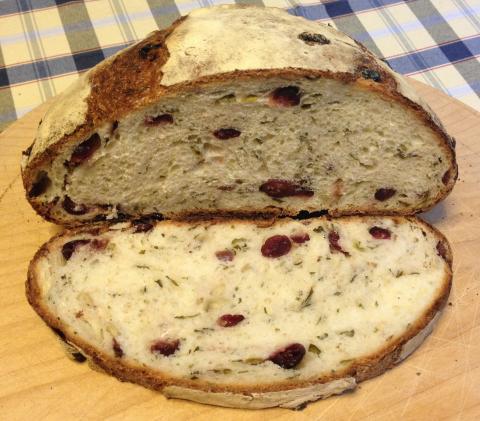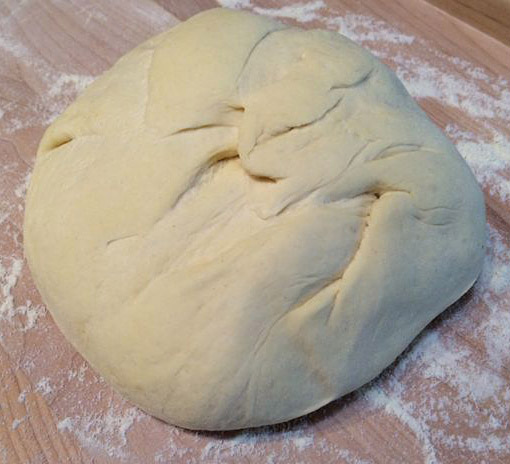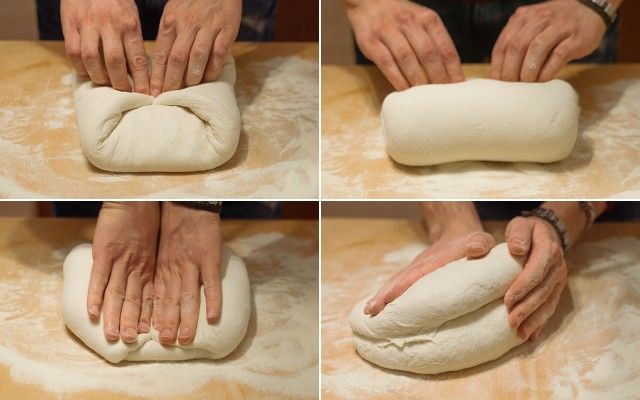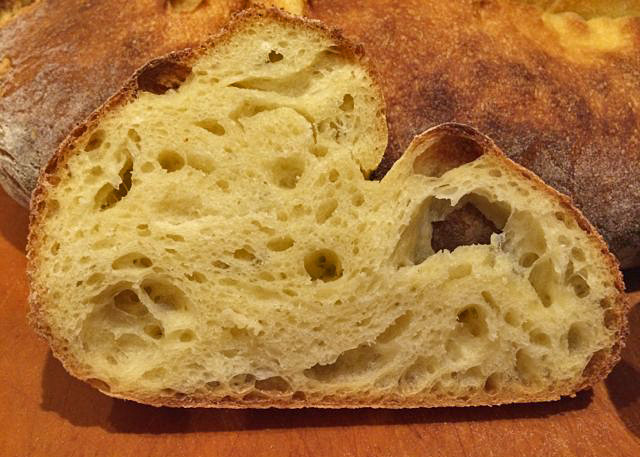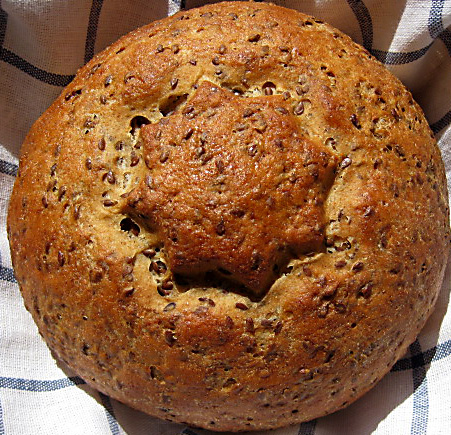This is the part of baking that is intimidating to many new bakers, and it doesn't need to be. Please take a few minutes to read this section and begin to learn what the dough should feel like and how to get it feeling like it is well developed. Many of us started baking by using a bread machine or a Kitchen Aid stand mixer to mix and knead the dough. While this works reasonably well, and other methods are described below, you will learn more quickly how the dough should feel in the different stages of development if you use the tools god gives us, our hands. For thousands of years humans have made good bread using only a crude bowl and their hands as tools. While commercial bakeries don't have the time to hand mix and shape thousands of loaves daily, much of what is wrong with commercial bread starts here in the first phase of bread making.
Mixing: Start by gathering all of the needed ingredients for the recipe. If you are making a basic French style bread that uses just the basic four ingredients (flour, water, salt and yeast), measure or better, weigh each item carefully ahead of time and have it in front of you ready to use. This might seem like over simplifying this procedure but I can tell you from experience you will forget the salt or pour all the water in without having measured it or can't remember some additional ingredient, if you don't get organized, first.
In a large bowl, add all of the dry ingredients first and stir or mix them together well. This means that Instant Dry Yeast and salt are added to the flour and any other dry ingredients you may be using with your recipe. NOTE: If you are using Active Dry Yeast, the directions for re activating this type of yeast call for adding the yeast to a cup or so of the water (warmed) needed for the recipe 5 or 10 minutes ahead of mixing the dough. If you are using Cake Yeast, crumble it with and into the flour using your fingers.
Continuing; Next, add all of the water and begin combining the flour into the water. You can use your fingers, (yes it will be a mess but it is supposed to be) or a spoon to accomplish this first mixing. Wood, Stainless Steel, Plastic, any kind of spoon or bowl will do fine. When the mixture is mostly a shaggy mass and looks like most of the dry flour is combined into the mass, you can stop, clean your hands over the bowl and cover the bowl with a plastic bag or a damp towel or plastic wrap. Plastic grocery bags are my favorite. Wait at least 15 minutes and as long as an hour for the flour to absorb the water. When you come back to the mix, it won't feel anything like it did after first mixing. Scrape everything you can onto a clean counter and quickly clean and dry the mixing bowl.
Kneading or Developing: This is the fun part of bread making. You are starting with a mixture of flour, water, salt and yeast. At the moment it is just those things put together in a bowl. We need to develop these things into something more, a smooth dough. The best way to show you or tell you how to accomplish this is with a video. There are many video clips that show similar techniques but this one I like the best. Richard Bertinet has produced an excellent video with Gourmet Magazine that shows the mixing technique above, and the slap and fold kneading technique that many of us now use in some form or another. I urge you to watch this video and learn to do this maneuver with the dough. As you will see in the video, the dough gradually comes together and becomes smooth and flexible. Bertinet is making a sweet dough with eggs and sugar but the method works on any kind of dough or bread type. Finish by rounding and putting tension on the outer skin of the dough and forming a ball.
Once the dough is well developed, smooth and rounded, lightly oil the now clean mixing bowl with a few drops of oil on your fingers (or lightly spray regular cooking oil into the bowl) and place the dough into the bowl, seams down and roll the ball around to coat all the surfaces. Cover the bowl as before during what is called the Primary Ferment. During the primary ferment, the dough will expand in volume as the yeast begins to eat the sugars in the flour and create Carbon Dioxide. Your well developed dough will trap those CO2 bubbles and form pockets that will become the air pockets in the bread, making it lighter.
NOTE: For Whole Grain and Multi-Grain breads, It is advisable to not try and develop the dough entirely by kneading. The sharper grains will cut the gluten strands and allow the CO2 gas to escape. A Stretch and Fold will often work as well, done during the primary ferment. A link to this procedure is provided below.
You can always come back to using some appliance to mix and knead your dough. In fact some doughs are somewhat better suited to machine mixing, but not many. You can easily produce wonderful bread in the manner of our ancestors.
Once the dough has doubled in volume you are ready for the next step, Shaping
There are a number of ways to develop dough. The easiest is probably to put it in a KitchenAid-type mixer. About 8 to 10 minutes of mixing the ingredients in a KitchenAid on low speed will generally do the trick.
There’s no need to buy a KitchenAid, though, to make good bread. Here are three ways of developing dough by hand.
Traditional Kneading: Use this method when the dough will rise fairly quickly (1-2 hours for the first rise) or if I’m in a hurry to get it developed.
First, mix the ingredients with a spoon until everything is hydrated. Cover and wait about 15 to 20 minutes – this way, you’ll let the water do most of your work for you (if you don’t have time for this step, feel free to skip it – you may have knead just a little more, though). After this waiting period is done, scrape the dough out of the bowl onto a smooth surface, and push on the down and forward with the heels of your hands. Fold it up back on itself, give the dough a quarter turn, and repeat.
Knead for about 4-5 minutes, and then cover it. Let it rest about 5 minutes, and then knead once again for 1-2 minutes. It should be well developed at this point.
One way to test dough development is to tear off a small chunk and then gently stretch it. If the dough is ready, you should be able to stretch it thin enough so that it becomes translucent. This is called the “windowpane” test.
Stretch and Fold: This method adds about an hour to the rise of an ordinary yeasted loaf, but when you’re working with sourdoughs or yeasted breads that have a long rise anyway, it doesn’t make that much difference. And it takes hardly active time at all – just a few minutes total. Really!
Mix the ingredients with a spoon until hydrated. Cover and wait 30 minutes to 1 hour. After this rest, scrape the dough out of the bowl and stretch it to about twice its length, if possible. For the first fold, the dough will still be pretty shaggy, so only go as far as you can without ripping. Fold the dough like a letter, give it a quarter turn, and then stretch and fold once again. Place it back in the bowl and cover.
Repeat this folding process twice more with 20-30 minutes in between each one.
More information and a video may be found here: http://www.sourdoughhome.com/stretchandfold.html
Stretching and Folding Illustrated: Here is the Stretch and Fold method illustrated by Mebake (Khalid). He has artfully depicted the process of keeping the dough in the bowl while developing the gluten and incorporating air into the dough. This easy to do technique is employed by many members here and allows the baker the opportunity to develop the gluten in a bowl during fermentation with little effort and no mess. Once you understand how this works, I'm sure you will use it every time.
French fold: This is a great, quick method for developing dough, but it requires a relatively long rest after everything is hydrated, so it’s most appropriate for doughs with a long bulk rise.
Once everything is hydrated, cover and let the dough rest for a least an hour. Remove the dough from the bowl onto a smooth surface. With one hand on either side of the dough and your thumbs underneath, stretch the dough parallel to your body while simultaneously folding it in half along its length with your thumbs.
Give the dough a quarter turn, pick it up, and then throw it down onto the surface, smooth side down. Really, smack it down. Stretch it again while simultaneously folding it over with your thumbs, make another quarter turn, and give it yet another smack with the smooth side down.
Do this about 10 times, and you’ll have a well developed dough. If it doesn't seem as developed as you'd like or if it starts to tear, let it rest for 5 minutes, and repeat.
A good video of this technique may be found here: http://www.gourmet.com/magazine/video/2008/03/bertinet_sweetdough
An alternative method: that keeps the dough in the bowl and all of the kneading is done there.
I use my fingers and scrape the dough into a single lump and flatten it and then fold it in half, turn it a quarter turn and fold again and flatten it. I continue this for about twenty folds. Often it gets very stiff and needs to rest for a few minutes to relax. As noted the dough will let you know when you have done enough. This stretches the original surface a million times the size it was at the start and assures a complete blending of the ingredients. I use this method because it confines the mess and permits making bread in less than ideal places. See the illustration mentioned above for a pictorial that describes this process.
There is no wrong way to knead bread but some ways are much better than others. Some breads benefit from special kneading and handling and some are very hard to get wrong. Before kitchens and mechanical mixers and tables there were dough troughs and all of the mixing and kneading was done there. You could make bread in a dough trough and bake it on a hot flat stone on an open fire.
No knead bread: For bread mixes that use very little leavening and are fairly wet, time provides the development.
Simply mix everything up until hydrated, cover and go to sleep. Anywhere from 12 to 18 hours later, give the dough one stretch and fold, shape as necessary, and then let it rise a couple of hours until it’s ready to bake. Learning to use a plastic scraper to handle dough in the mixing bowl, as described below, is a big help.
Alternative video: If you are just a little adventurous, Check out this excellent video, provided by Mark Sinclair of The Back Home Bakery. Mark demonstrates folding in the bowl using a plastic scraper over a period of time to develop strength in the dough. This and all of Marks videos are excellent training aids.

